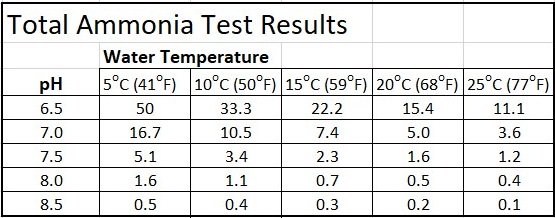| Back to Back Issues Page |
 |
|
The Goldfish Gazette, Issue #108 The Ammonia Test December 29, 2022 |
Goldfish Care TipsA Free Monthly Resource For Goldfish Enthusiasts In This Issue Ammonia is one of the biggest killers of fish in aquariums, ponds, and in the environment. The Ammonia Test
Anything above zero indicates water conditions are either not yet suitable for fish in a new setup, or, water conditions are becoming dangerous in an established aquarium or pond for some reason, either a filter has failed, or something is polluting the water. But is the ammonia test telling us the whole story? Understanding Test Kit Ammonia ResultsBeing the holiday period, we don’t want to be reading heavily detailed scientific information, so I will keep this short and summarized.Ammonia test kits read Total Ammonia. This is made up of two parts, toxic ammonia resulting from decomposing waste, fish urine, and fish breathing (NH3), and the much less toxic ionized ammonia (ammonium NH4+). The important factor in the Total Ammonia reading is, how much toxic ammonia is present compared to the less toxic ammonium NH4+. The amount of toxic ammonia is governed by two parameters, water temperature, and pH. Many fish-keeping guides warn anything above 2.0 ppm (mg/l) is lethal with damage to gills occurring at 0.05 ppm, but this is misleading. To illustrate this, if the water temperature is 5oC (41oF), and the pH reading is 6.5, the Total Ammonia reading can be 50 ppm before the toxic ammonia level would be lethal. At the other extreme, if the water temperature is 25oC (77oF), and the pH reading is 8.5, the Total Ammonia reading can only be 0.10 ppm before the toxic ammonia level would be lethal. I was recently reminded of this when forced to keep some juvenile fish in a 90L (24 gallon) tub with an un-cycled filter. I monitored the water closely and made weekly partial water changes. It was the middle of winter and I was feeding lightly. PH tests were at around 7.0 which should have rung alarm bells (dropping pH indicates a build-up of nitrates, indicating a working filter). I retested for ammonia at about 4 weeks. The reading was 4.0 ppm. The fish should have all been dead! I then realized the water temperatures were low, around 12oC (54oF), and the pH around 7.0. These two factors saved the fish. Needless to say, there was a rapid total water change made. The chart below details when Total Ammonia is toxic depending on the pH level and water temperature. 
Ammonia Binding Products and Test ResultsSome water conditioning products modify the ammonia molecule making it non-toxic, however, the ammonia still remains in the water. If you use an ammonia test using Nessler reagents, the test can’t distinguish between toxic and non-toxic ammonia, but a test using Salicylate reagents can. The difference between the tests is the Nessler reagent tests come in a single bottle, and the Salicylate reagent tests come in two bottles and are slightly more expensive. The popular API test kits are the Salicylate type. SummaryAs long as our ammonia tests are reading zero, we don’t have to be too concerned about the Total Ammonia result, however, if our water conditions change dramatically and we need to take corrective action, we need to be aware of the consequences of raising water temperatures and adding pH buffers.Happy New YearWhen wishing you a happy and prosperous 2022, I wasn’t expecting Covid-19 to be as prevalent as it still is, nor the criminal invasion of a Sovereign State by Russia.So, again I wish you, your families, and your Goldfish a happy and prosperous new year, and to spare a thought for the people of Ukraine and what they are enduring. We pray for a speedy resolution. Comments? Ideas? Feedback? I'd love to hear from you. Just reply to this e-zine and tell me what you think, or what topics you want to be covered. Next Month's Topic Mosquito Larvae - Goldfish Super Foodwww.facebook.com/aboutgoldfish |
| Back to Back Issues Page |
